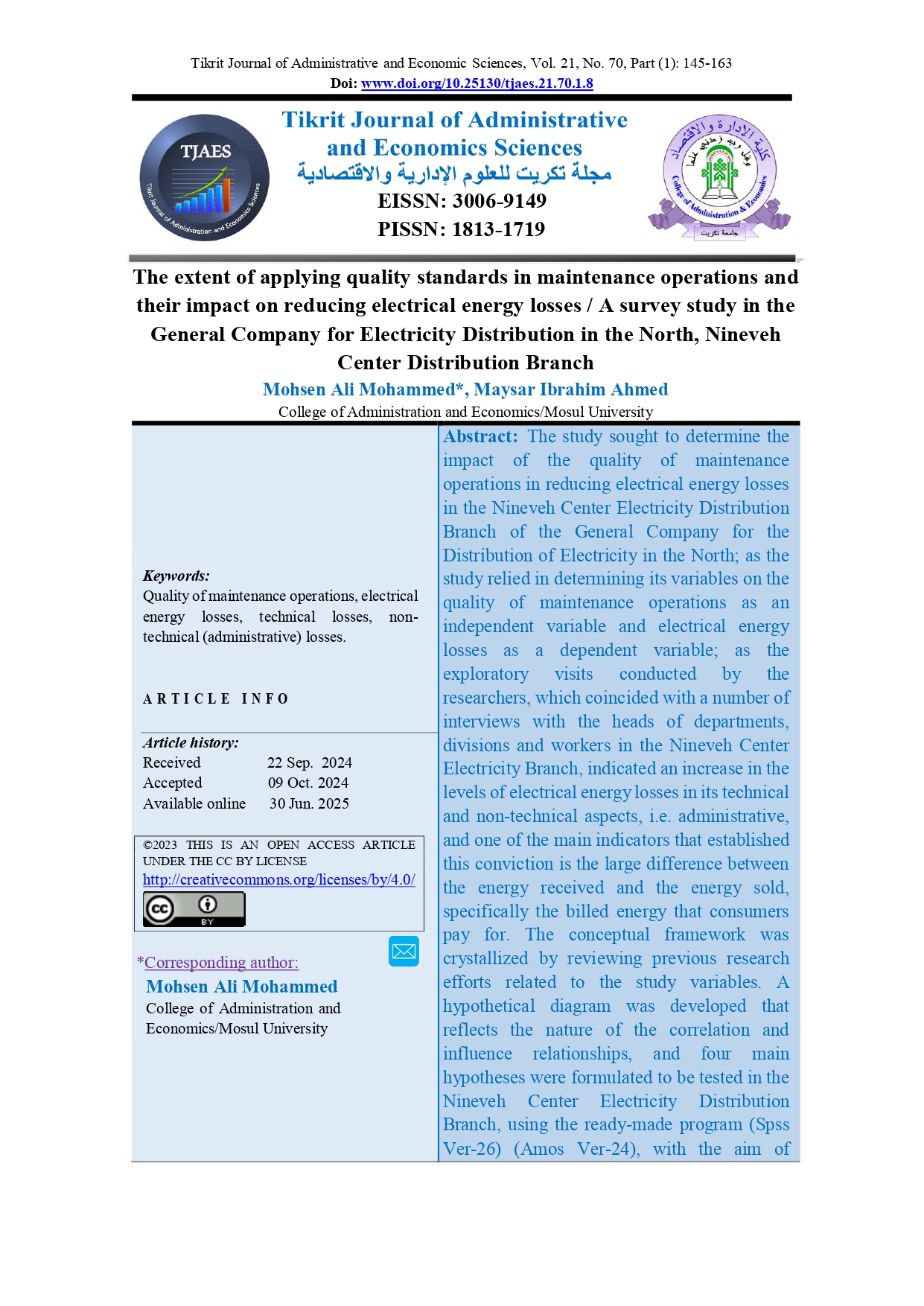The extent of applying quality standards in maintenance operations and their impact on reducing electrical energy losses / A survey study in the General Company for Electricity Distribution in the North, Nineveh Center Distribution Branch
Main Article Content
Abstract
The study sought to determine the impact of the quality of maintenance operations in reducing electrical energy losses in the Nineveh Center Electricity Distribution Branch of the General Company for the Distribution of Electricity in the North; as the study relied in determining its variables on the quality of maintenance operations as an independent variable and electrical energy losses as a dependent variable; as the exploratory visits conducted by the researchers, which coincided with a number of interviews with the heads of departments, divisions and workers in the Nineveh Center Electricity Branch, indicated an increase in the levels of electrical energy losses in its technical and non-technical aspects, i.e. administrative, and one of the main indicators that established this conviction is the large difference between the energy received and the energy sold, specifically the billed energy that consumers pay for. The conceptual framework was crystallized by reviewing previous research efforts related to the study variables. A hypothetical diagram was developed that reflects the nature of the correlation and influence relationships, and four main hypotheses were formulated to be tested in the Nineveh Center Electricity Distribution Branch, using the ready-made program (Spss Ver-26) (Amos Ver-24), with the aim of diagnosing the relationship between the study variables. The researchers adopted the descriptive analytical approach in presenting the theoretical foundations, and the quantitative application to support the results of the study that were reached by the researcher adopting a set of tools in collecting data and information represented by the questionnaire form, in addition to personal interviews and field visits. A sample consisting of (287) respondents was identified, and quantitative data on maintenance operations and electrical energy losses that we obtained from the branch records were adopted,
Downloads
Article Details
References
اولاً. المصادر العربية:
الجبوري، ميسر إِبراهيم أَحمد،2021، إِدارة الجودة العاصرة جوانب نظرية وتطبيقات، الطبعة الثالثة،كلية الإِدارة والاقتصاد / جامعة الموصل، جمهورية العراق.
علو، علي صبري & عباس، محمد سعد،(2013)، تقليل الخسارة في الطاقة على خطوط التوزيع في نظم الطاقة الكهربائية: تقليل، الخسارة، في، الطاقة، على، خطوط، التوزيع، في، نظم، الطاقة، الكهربائية، مجلة الكلية الاسلامية الجامعة المجلد 1، العدد 25، ص 67-83.
ثانياً. المصادر الاجنبية:
Shiomi, R., Shimasaki, H., Takano, H., & Taoka, H. (2019). A study on operating lifetime estimation for electrical components in power grids on the basis of analysis of maintenance records. Journal of International Council on Electrical Engineering, 9(1), 45–52. https://doi.org/10.1080/22348972.2019.1612975
Mbembati, H., Ibwe, K., & Maiseli, B. (2023). Maintenance Scheduling Algorithm for Transformers in Tanzania Electrical Secondary Distribution Networks. Tanzania Journal of Science, 49(1), 167-182. https://doi.org/10.4314/tjs.v49i1.15
Vita, V., Fotis, G., Chobanov, V., Pavlatos, C., & Mladenov, V. (2023). Predictive Maintenance for Distribution System Operators in Increasing Transformers’ Reliability. Electronics, 12(6). https://doi.org/10.3390/electronics12061356.
Choma, A. M. (2018). Reliability Evaluation of an Electric Power Distribution System: A Case Study in Gauteng Metropolitan Municipality (Publication Number 28284193) [M.E., University of Johannesburg (South Africa)]. ProQuest Dissertations & Theses Global. South Africa. https://ujcontent.uj.ac.za/vital/access/manager/Repository/uj:31957?site_name=GlobalView
Franck, C. M., Hsu, C. C., Xiao, Y., Bleuler, P., Frusque, G., Muratovic, M., & Polonelli, T. (2023). Transmission and distribution equipment: providing intelligent maintenance. IEEE Power and Energy Magazine, 21(2), 18-29. https://doi.org/10.1109/mpe.2022.3230968
De Oliveira, M. M., & De Oliveira, P. M. F. (2023). Maintenance Strategy Based on Reliability: Case Study of a Company in the Electric Sector. Revista Latino-Americana de Inovação e Engenharia de Produção, 10(18).
https://doi.org/10.5380/relainep.v10i18.87068
Parasuraman, A., Zeithaml, V. A., & Berry, L. L. (1985). A conceptual model of service quality and its implications for future research. Journal of marketing, 49(4), 41-50.
Obafemi, F. N., & Ifere, E. O. (2013). Non-technical losses, energy efficiency and conservative methodology in the electricity sector of Nigeria: The case of Calabar, Cross River State. International Journal of Energy Economics and Policy, 3(2), 185-192.
da Silva, G. G., de Queiroz, A., Garbelini, E., dos Santos, W. P. L., Minussi, C. R., & Bonini Neto, A. (2024). Estimation of Total Real and Reactive Power Losses in Electrical Power Systems via Artificial Neural Network. Applied System Innovation, 7(3), 46. https://doi.org/10.3390/asi7030046
Goglio, A. (2021). Meter tampering detection through short-lived patterns clustering (Master's thesis, Universitat Politècnica de Catalunya).
Shah, A. L. (2018). Accurate detection and correction of technical and non-technical losses using smart metering (Master's thesis, King Fahd University of Petroleum and Minerals (Saudi Arabia).
Au, M. T., & Tan, C. H. (2013, June). Energy flow models for the estimation of technical losses in distribution network. In IOP Conference Series: Earth and Environmental Science (Vol. 16, No. 1, p. 012035). IOP Publishing.
Guerrero, J. I., Monedero, I., Biscarri, F., Biscarri, J., Millan, R., & Leon, C. (2017). Non-technical losses reduction by improving the inspections accuracy in a power utility. IEEE Transactions on Power Systems, 33(2), 1209-1218. https://doi.org/10.1109/tpwrs.2017.2721435
Zanetti, M., Jamhour, E., Pellenz, M., Penna, M., Zambenedetti, V., & Chueiri, I. (2017). A tunable fraud detection system for advanced metering infrastructure using short-lived patterns. IEEE Transactions on Smart grid, 10(1), 830-840. https://doi.org/10.1109/tsg.2017.2753738


